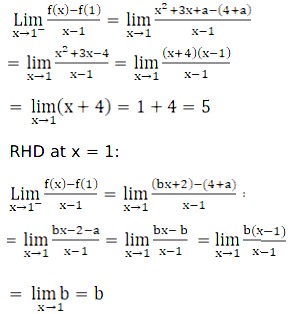It is given that f(x) is differentiable at each x є R
For x ≤ 1,
f(x) = x2 + 3x + a i.e. a polynomial
for x > 1,
f(x) = bx + 2, which is also a polynomial
Since, a polynomial function is everywhere differentiable. Therefore, f(x) is differentiable for all x > 1 and for all x < 1.
f(x) is continuous at x = 1
\(\lim\limits_{x \to 1^-}\) f(x) = \(\lim\limits_{x \to 1^+}\) f(x) = f(1)
\(\lim\limits_{x \to 1}\) (x2 + 3x + a) = \(\lim\limits_{x \to 1}\) (bx+2) = 1 + 3 + a
12 + 3(1) + a = b (1) + 2 = 4 + a
4 + a = b + 2
a – b + 2 = 0 …(1)
As function is differentiable, therefore,
LHD = RHD LHD at x = 1:

As, LHD = RHD
Therefore,
5 = b
Putting b in (1), we get,
a – b + 2 = 0
a - 5 + 2 =0
a = 3
Hence,
a = 3 and b = 5